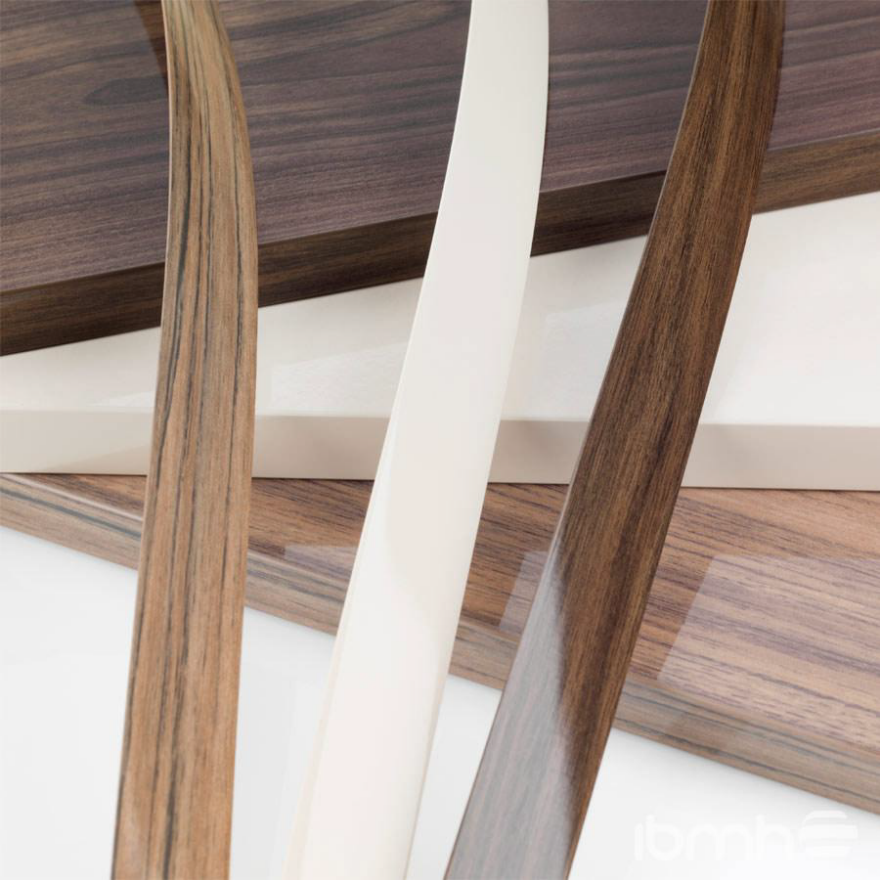When you design a product, you never really know how it's going to be perceived. The second it hits someone else's eyeballs, your design goes through the filters of that person's experiences.
So let's talk about looking at a design critically. Not "critically" in the manner of a troll, but as in analyzing a design's merits and perceived faults. First we'll look at this piece with fresh eyes, the way a "civilian" might. Then we'll examine it from the perspective of someone with a bit of a design background.
This is the Luno EGB2 Record Console. The Mid-Century-Modern-inspired piece contains a built-in sound system including a turntable, amplifier, subwoofer and two-way speakers. It also features a minibar with gold-rimmed glasses and storage for 150 LPs.
![]() Luno - EGB2
Luno - EGB2I love that this vintage-looking piece recalls a time when moments in our lives could center around interacting with a piece of furniture. You can imagine coming home from a hard day, flipping the lid open, selecting a record, placing in on the platter, pouring yourself a whiskey. If you're a record owner, the EGB2 is something you'd save up for and keep in the family. This would be the centerpiece of a room.
![]() Luno - EGB2
Luno - EGB2 ![]() Luno - EGB2
Luno - EGB2 ![]() Luno - EGB2
Luno - EGB2 ![]() Luno - EGB2
Luno - EGB2 Now let's take a closer look. The description states:
The beautiful Mid Century inspired design…effectively evoke[s] the luxurious style and modernist design of the Mad Men era. Each EGB2 is crafted by finely skilled artisans in the USA using American Walnut and would undoubtedly be a conversation piece based on it's [sic] stylish design alone.
Even if you don't have a design background, chances are high that you know walnut is considered a premium wood. The piece is described as being made of walnut and mentions no other materials, so your perception of this piece is that it's made of a premium material.
But if we look closer, we see this:
![]() Luno - EGB2
Luno - EGB2 As we mentioned in the post on edge-banding, there is a grain disconnect here. These pieces have been edge-banded, indicating that they are probably walnut-veneered plywood or particle board. That's hardly illegal—there is no FDA for furniture demanding that you disclose the "ingredients" of all furniture pieces—though it does bug us when this admittedly common practice is not disclosed in the product's description.
Anyways, here is the part I'd like to ask those of you with design backgrounds about. It concerns these arches:
![]() Luno - EGB2
Luno - EGB2 To a layperson, they merely seem a decorative element. But to a Mid-Century Modern aficionado (which I am not) or to anyone forced to sit through a History of Furniture Design course (which I was), they represent something else. Please look at the photographs below, which are of pieces created by furniture manufacturer Broyhill in the 1960s:
![]() Broyhill - Brasilia
Broyhill - Brasilia![]() Broyhill - Brasilia
Broyhill - Brasilia ![]() Broyhill - Brasilia
Broyhill - Brasilia ![]() Broyhill - Brasilia
Broyhill - Brasilia That's Broyhill's Brasilia line. It hit the market in 1962, with furniture inspired by the (then-new) architecture style of Brasília, Brazil's capital.
![]() Brasília
Brasília ![]() Brasília
Brasília ![]() Brasília
Brasília ![]() Herman Miller logo, 1940s
Herman Miller logo, 1940sThe parabolic arc was already a visual staple of the time—heck, Herman Miller had had it as part of their logo (left) since the '40s—but Broyhill really ran with it here, incorporating two opposing arcs as a motif across a wide variety of furniture.
![]() Broyhill - Brasilia
Broyhill - Brasilia![]() Broyhill - Brasilia
Broyhill - Brasilia ![]() Broyhill - Brasilia
Broyhill - Brasilia ![]() Broyhill - Brasilia
Broyhill - Brasilia That the Luno piece was inspired specifically by the Brasilia line is not in question, nor is it illegal. My question to you is, ought the designer of the EGB2 have said "Broyhill-Brasilia-inspired" rather than "Mid-Century-inspired?" Or are the arches, as distinctive as they are, completely fair game?
Perhaps Luno can't be faulted at all. The Brasilia line first appeared in 1962. In 1963, Broyhill competitor Kent Coffey, also based in North Carolina, released their Perspecta line:
![]() Kent Coffey - Perspecta
Kent Coffey - Perspecta![]() Kent Coffey - Perspecta
Kent Coffey - Perspecta ![]() Kent Coffey - Perspecta
Kent Coffey - Perspecta ![]() Kent Coffey - Perspecta
Kent Coffey - Perspecta ![]() Kent Coffey - Perspecta
Kent Coffey - Perspecta ![]() Kent Coffey - Perspecta
Kent Coffey - Perspecta I think this is why issues of design copyright can be so tricky. I can imagine the absurdity of lawyers trying to discuss these arches in a court of law. Yet if I were the Broyhill designer and later spotted the Luno piece or the Perspecta line, I'd surely do a double-take.
Two questions for you:
1) If you were the Broyhill designer, what would you think after seeing the Kent Coffey and Luno pieces?
2) If you were the Luno or Kent Coffey designers, what would you say to the Broyhill designer if pressed on the similarities?
![]()
![]() Winner
Winner![]() Runner Up
Runner Up![]() Notable
Notable![]() Notable
Notable![]() Notable
Notable![]() Notable
Notable![]() Student Winner
Student Winner![]() Student Runner Up
Student Runner Up![]() Student Notable
Student Notable![]() Student Notable
Student Notable![]() Student Notable
Student Notable

























































































































































